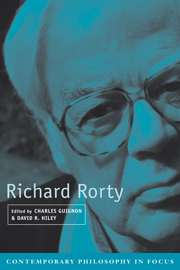Book contents
- Frontmatter
- Contents
- Contributors
- Acknowledgments
- Abbreviations
- Richard Rorty
- 1 Introduction: Richard Rorty and Contemporary Philosophy
- 2 Rorty's Critique of Epistemology
- 3 Rorty on Knowledge and Truth
- 4 From Realism or Antirealism to Science as Solidarity
- 5 Rorty's Democratic Hermeneutics
- 6 Rorty's Inspirational Liberalism
- 7 Don't Be Cruel: Reflections on Rortyan Liberalism
- 8 Rorty and Philosophy
- Bibliography
- Index
4 - From Realism or Antirealism to Science as Solidarity
Published online by Cambridge University Press: 18 December 2009
- Frontmatter
- Contents
- Contributors
- Acknowledgments
- Abbreviations
- Richard Rorty
- 1 Introduction: Richard Rorty and Contemporary Philosophy
- 2 Rorty's Critique of Epistemology
- 3 Rorty on Knowledge and Truth
- 4 From Realism or Antirealism to Science as Solidarity
- 5 Rorty's Democratic Hermeneutics
- 6 Rorty's Inspirational Liberalism
- 7 Don't Be Cruel: Reflections on Rortyan Liberalism
- 8 Rorty and Philosophy
- Bibliography
- Index
Summary
There is nothing wrong with science, there is only something wrong with the attempt to divinize it, the attempt characteristic of realistic philosophy.
(ORT 34)The pragmatist tradition, with which Richard Rorty actively aligns himself, has long been closely affiliated with the sciences. Pragmatists such as John Dewey or Willard van Orman Quine have understood themselves to be philosophical naturalists, where “naturalism” is defined as the view that philosophy is continuous with, or even a part of, a scientific understanding of the world. The significance of such a proposed assimilation of philosophy to science depends, however, upon the specific conception of science and scientific understanding that philosophy is supposed to emulate. An important and controversial aspect of Rorty's own contribution to pragmatism has been his reformulation of the terms in which we should understand the sciences and the scientific culture that the pragmatists endorse.
Rorty's conception of science, along with his view of the relations of science to philosophy and to culture more generally, has evolved in conversation with philosophical debates about scientific realism, and about a broader conception of scientific “objectivity” that scientific realism exemplifies. Part of the difficulty of getting a handle on these arguments, and on Rorty's own position, is that the term “realism” has been fraught with ambiguity. Sometimes it has been used simply to assert continuity between the familiar objects of our everyday surroundings and the strange and often unobservable objects postulated within scientific theories (electrons and black holes are just as real as tables and chairs).
- Type
- Chapter
- Information
- Richard Rorty , pp. 81 - 104Publisher: Cambridge University PressPrint publication year: 2003
- 1
- Cited by



